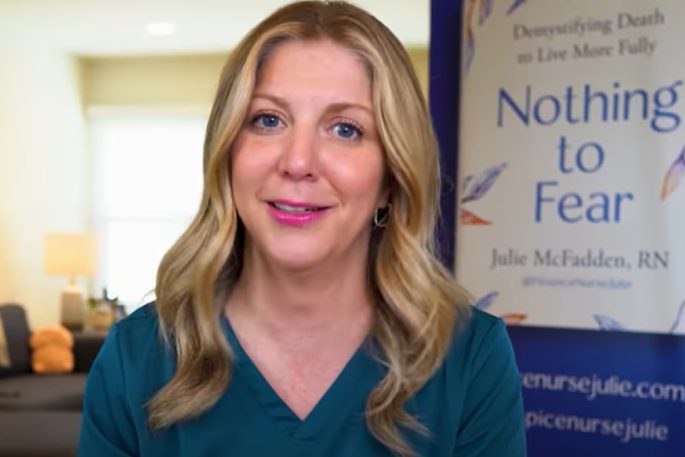A hospice nurse has lifted the lid and revealed the six “unimaginable” things that happen to someone when they are on their deathbed.
Registered Los Angeles nurse and author Julie McFadden specialises in hospice care, and has dealt with hundreds of people who are in the process of dying.
The 41-year-old has taken to social media, building a following of millions, to share insights into the process of “death and dying” and help destigmatise the things people at the end of their life experience.
Julie says that there are six phenomena surrounding death that she was initially uncomfortable sharing until she witnessed them for herself.
She hopes her insight will help comfort both those going through their last days of life and family members who have to witness their loved ones dying.
Julie says that patients often experienced “terminal lucidity”, “hallucinations” and “death stares” among other things.
“There are many death-bed phenomena and I’ve seen them all, let’s break them down. I want to be clear this doesn’t happen to everyone but it does happen enough that I like to educate about it,” she begins in her YouTube clip.
“Coming on to hospice and becoming a hospice nurse, I was educated about it and was told to educate families about it. And surely as the years went on and I started seeing things more and more, it became apparent that I definitely needed to educate people about it because it happens so often.”
Terminal lucidity
She first says that many people suffer terminal lucidity, something she describes as a “burst of energy” from a patient who is nearing death.
While she doesn’t know why it happens, she says: “Just enjoy it and expect that maybe they will die soon after because that’s the kicker with terminal lucidity, it looks like someone’s going to die very soon then suddenly they have a burst of energy.
“They maybe have a really great day, they’re suddenly hungry, they’re suddenly able to walk, they’re suddenly very alert and oriented, and then shortly after usually a day or two they will die, so that can be the hard part if you’re not ready for it, if you don’t know what’s coming you can think they’re getting better and then they die, which can be very devastating.”
 Terminal lucidity is a common occurrence in someone approaching death. File Photo.
Terminal lucidity is a common occurrence in someone approaching death. File Photo.
Visioning
Julie says that someone on their death bed might experience “visioning”. She described it as suffering from “hallucinations” and that it was one of the most talked about phenomena by both the person dying and their family.
Part of experiencing visioning is seeing people who have already passed weeks before their death.
“I wouldn’t have believed it unless I saw it for myself over and over again,” the nurse admitted. She says it’s best to “just go with it” if a loved one does experience a hallucination and sees someone from the past.
If they see dead people, she says they’re roughly a month away from dying themselves.
Choosing when you’re going to die
The hospice nurse says this one can be the most confronting, explaining the dying patient can often “feel” when their time is up and predict when it’ll happen.
“Number three, this is really crazy - people choosing when they’re going to die. I have seen some extreme cases of this, people just saying, ‘Tonight’s when I’m going to die I know it, I can feel it,’ and they do.
“There’s also a time when people will wait for everybody to get into town or get into the room arrive at the house whatever it is and then they will die,” the nurse says.
Death reach
The death reach can be confronting, Julie says, but is something that often happens to those days or hours away from dying.
“It’s when the person’s lying in bed and they reach up in the air like they’re seeing someone or they’re reaching for someone either to hug them or to shake their hands. A lot of times they’ll hold their hands up for a long time.
“[It’s] like they’re seeing something that we’re not seeing and they’re reaching for someone that we can’t see.”
Death stare
Julie says that the death stare often goes along with the death reach.
She says it looks like someone staring off into the corner of the room looking at something intently.
“But if you’re snapping your finger in front of their face or trying to say their name to kind of snap them out of it, they won’t.”
Shared death experience
The last phenomenon Julie discusses is the shared death experience, which she describes as the “most impactful”.
She says it’s when the dying person gives you the sensation of what they’re going through.
“There may have been some times where that’s not a good thing, but from my experience and all the stories I’ve heard it’s usually a good feeling.
“From what I experienced, it was a very good feeling. It was like the person was giving me these feelings of freedom and joy and kind of telling me that they were okay and basically they couldn’t believe how amazing it was again.
“At the time, I was shocked, I didn’t know what was happening, but I’ve come to find out that that’s called a shared death experience.”
Later this year, Julie plans to release a book titled Nothing To Fear, hoping it’ll provide a “comforting and informative guide that demystifies our end-of-life journey”.



0 comments
Leave a Comment
You must be logged in to make a comment.